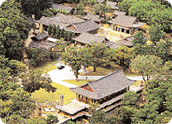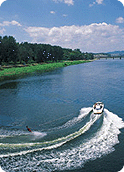|
|
|
| |
|

|
 |
Gatbawi is a greate stone Buddha with stone hat
on his head sitting on top of Gwanbong Peak, which
is 850m high above sea level. Gwanbong Peak is the
east end of the Palgongsan mountain ridges. A parking
lot, restaurants, and other facilities are prepared
for visitors.
From the parking lot, a long trail of stone steps
leads to the top of the peak. The walk along the
steps takes about one hour. |
Gatbawi is about a 4m tall sitting
stone Buddha. Its official name is Gwanbong Seokjoyeoraejwasang(Gwanbong
sitting stone Buddha). He wears a hat which is about
a 15cm thick flat stone on his head, so it(He) is
called Gatbawi.
The stiff lips of his closed mouth and his stout
body show the impression of majestic mercy. It is
a representative work of art from the Unified Silla
Kingdom. It is designated as Treasure Number 431.
Gatbawi Park Management Office Tel. 983-8586 http://www.seonbonsa.org |
|
 |
|
|

|
 |
This more than a millennium year old temple was
built during the period of the Silla Dynasty in
Dohak-dong Valley where tributary valleys (Pokpogol(cascade)Valley,
Bindaegol Valley, and Susutgol Valley) converge.
The temple was originally founded by Priest Geukdal,
and named as the Yugasa Temple. Later it was reconstructed
by the Great Buddhist Teacher Simji.
At that time flowers of the paulownia trees(O-Dong)
|
were in full blossom foretelling
good omen and the temple was renamed as the Donghasa
Temple.
The first building visitors come across is the Bongseoru
Tower. This tower symbolizes the Chinese phoenix
which is known to build its nest in a paulownia
Donghwasa Temple Tel. 982-0101 |
|
 |
|
|

|
 |
This Park is located 1.4km away from the Hwranggyo
Bridge on the upper stream of the Geumho River.
Elementary students and others who enjoy the winding
river and the lawn on the riverbank visit this place.
This is an environment-friendly ecological park
which preserves an old rural district atmosphere.
This park also shows us that without destroying
the ecosystem we can develop riverside parks. |
| It has a basketball court, benches.
street lamps, a promenade and sports facilities. |
|

|
 |
Dongchon resort is an old resting place of citizens
which is located along the Geumho River in Dongchon.
There are various recreational facilities and roads
for driving. Geumho River has a suspension bridge
and the Ayanggyo Bridge. It is a good place for
leisure having a cable car, suspension bridge, and
athletic facilities. |
|

|
 |
This alley, Dakddongjip Alley (Large intestine
of chicken restaurants alley) first started with
4 restaurants in 1983, and presently it has about
50 restaurants scattered throughout Pyeonghwa Market
in Sinam-dong, You can taste the very special flavor
of these restaurants at a low price, but you cannot
experience this kind of restaurant alley in any
other place. |
|
 |
|
|

|
 |
The historic site of General Sin and his relics
is located near the Pagunjae Pass on the way from
the entrance of Mt. Palgongsan to the Pagyesa Temple.
The general was one of the founding fathers of the
Goryeo Dynasty. After saving the king's life in
the Gongsan Battle, he died heroically. In 927 AD,
the army of King Gyeon-hwon of the Later Baekje
Kingdom invaded the millennium old declining Silla
Kingdom and brutally plundered it. |
Wang Geon, the king of Later Goguryeo
Dynasty, with his troop of five thousand soldiers
fought against Gyeonhwon's army at Dongsu of Mt.
Palgongsan in aid of the Silla Kingdom. Wang Geon's
army was losing the battle, and Wang Geon's life
fell in danger. At this moment, General Sin put
on King Wang Geon's armor to cheat the enemy and
was killed in the battle. After unifying the later
three kingdoms, King Wang Geon built the Jimyosa
Temple in condolence of General Sin. Pyochungdan
(the altar expressing loyalty) is the old site (ruins)
of the Jimyosa Temple. It is situated on the roadside
about 500 m away from the Pagunjae Pass toward the
Pagyesa Temple. Jimyosa Temple was deserted with
the decline of the Goryeo Dynasty. During the Joseon
Dynasty, Pyochungdan, Pyochungsa Temple, and Chungyeolbi
Stele were built and erected in that ruins. Pyochungdan
is now a peaceful place with crapemyrtles, and is
surrounded with low and neat walls.
There are lots of place names and folk tales related
to King Wang Geon in Mt. Palgongsan. Pagunjae Pass
is the place where Wang Geon was defeated by Gyeonhwon.
Wangsan is the place where Wang Geon hid for his
life in escape from the pursuit of Gyeonhwon. Banyawol
(a half moon) is the place where the fleeing Wang
Geon saw the solitary moon. Ansim (peace in mind)
is the place where Wang Geon felt safe. |
|
 |
|
|

|
 |
About 10years ago this alley was created and presently
about seven restaurants are featuring their specialties:
thick bone soup and potato. Many visitors from other
areas and people who fly to Daegu come to this place
because this alley is near the Daegu International
Airport. |
|
| |
|
|
|
|
|